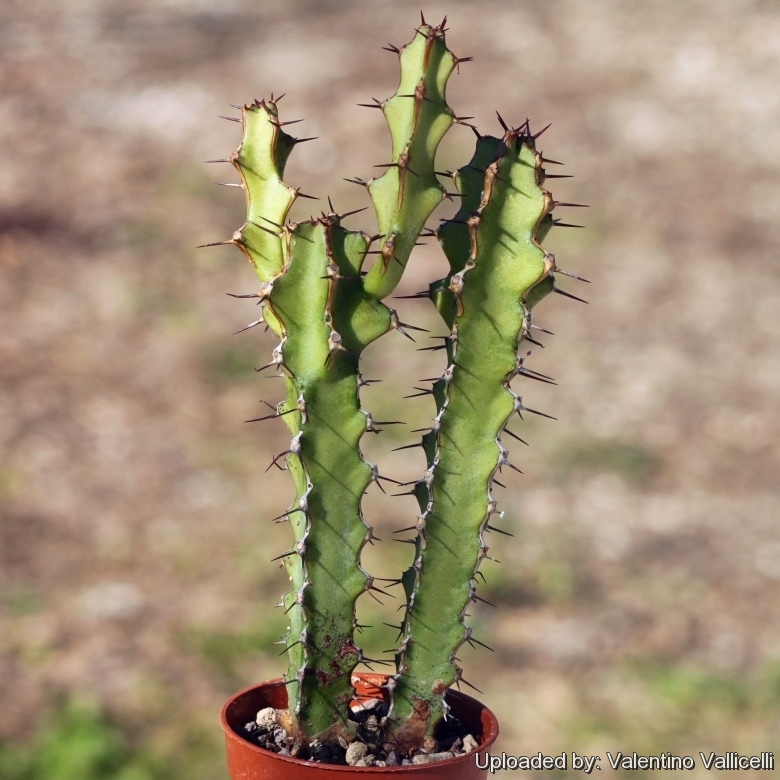
Euphorbia heterochroma Photo by: Valentino Vallicelli
Origin and Habitat: Widespread in North-East Tanzania
Altitude: 450 - 1300 m above sea level.
Habitat: It grows on sandy stony soils in rocky hills with Acacia bushland.
Synonyms:
See all synonyms of Euphorbia heterochroma
Common Names include:
MAASAI or MASAI (ɔl Maa): Enleusanoi
Description: Euphorbia heterochromaSN|25191]]SN|25191]] is a small cactus-like spiny succulent shrub up to 2 m tall. The thin branched stems are attractively marked and may or may not have thorns. The species is very distinct from all those most nearly allied to it and easily recognised by its long-exserted small capsule.
Branches: Uniformly thick, only slightly constricted at intervals corresponding to the end of each growing season, more or less distinctly variegated, 4(-5)-angled, less than 20 mm wide, with flattish sides, angles not toothed, shallowly undulate with teeth to 2.5 cm apart.
Spine-shields: Elongated to 20 x 2 mm quite separate or, occasionally, joined in a continuous horny margin.
Spine pairs: 1-6 mm or vestigial below the leaf-scars of constant length within each period of growth.
Stipular spines: Small placed one on each side of the leaf-scar. These prickles are sometimes well developed, sometimes quite absent ( reduced to mere points) on the same branch, and in most cases, quite useless for distinctive purposes.
Inflorescences: Cymes solitary, simple; peduncles stout, to 3 mm: Cyathia 6 mm in diameter yellow; Nectar glands oblong, touching
Fruits (Capsules): Long-exserted, born on small cymes, buff, acutely lobed, approx. 3 x 5,5 mm, styles 1-2 mm long. Pedicels about 5 mm long, recurved.
Seeds: Ovoid. 2,2 x 2 mm, shallowly tuberculate.
Subspecies, varieties, forms and cultivars of plants belonging to the Euphorbia heterochroma group
 Euphorbia heterochroma Pax: Has distinctly variegated branches with spineshields usually not joined. Cyathia and nectar glands yellow. Distribition: North-East Tanzania.
Euphorbia heterochroma Pax: Has distinctly variegated branches with spineshields usually not joined. Cyathia and nectar glands yellow. Distribition: North-East Tanzania.- Euphorbia heterochroma subs. tsavoensis S.Carter: Has no-variegated branches with spineshields all joined. Cyathia and nectar glands red. Distribition: South-east Kenya, Machakos Distr.
Bibliography: Major references and further lectures
1) Urs Eggli “Illustrated Handbook of Succulent Plants: Dicotyledons” Volume 2. Springer, 2002
2) Pax in H.G.A.Engler, "Pflanzenw. Ost-Afrikas" C: 242 (1895)
3) J. G. Baker, and C. H. Wright “Flora of Tropical Africa” Vol 6 Part 1, page 441 (1913)
Cultivation and Propagation: Euphorbia heterochromaSN|25191]]SN|25191]] is an ornamental Euphorbia with short spines, but not really a concern. It is easy to grow and tolerate neglect.
Growth rate: It has a relatively rapid seasonally growth.
Soil and pots: It likes pots with generous drain holes, needs a very airy potting medium which mainly consists of non organic material such us clay, pumice, lava grit, and only a little peat or leaf-mould. Re-pot every two years.
Fertilization: Need a perfect fertilizer diet in summer. Use preferably a cacti and succulents fertilizer with high potassium content including all micro nutrients and trace elements or slow release fertilizer.
Exposure: This plant has an excellent heat tolerance, and need full sun to light shade exposures, but can tolerate shade. However shade grown plants will tend to produce fewer, and badly etiolated growth (weak, gangly stems with unusually long internodes, and generally paler green coloration). The colour of this plant is much more marked if grown in full sun. But if it is possible to keep the growth of this species compact, with denser, shorter stems of a more uniform length (rather than looking weedy) such plants can be outright attractive.
Watering: Water regularly during the active growing season. No water should ever be allowed to stand around the roots. Keep almost completely dry in winter. Even though it is extremely drought tolerant, during the active growing season it is best to keep its soil reasonably moist, watering it about once every week.
Hardiness: Tender. This spurge is difficult to get it to look its best without a good amount of heat and sun and so it is only really suited to the tropics (USDA Zones 10-11). Keep the plant cooler at in winter, but maintain the light as bright as you can so that any growth which it may produce at this time will not be etiolated. It can be grown outdoors in the summer months to benefit from direct exposure to light, and especially exposure to high summer temperatures.
Rot: Rot it is only a minor problem with Euphorbias if the plants are watered and “aired” correctly. If they are not, fungicides won't help all that much.
Known hazards: The latex/sap is poisonous and can cause skin rash, itching and general discomfort, and they should be handled with caution, particularly when pruning.
Propagation: The plant can be reproduced by seeds or cuttings. The seed will loose viability in storage, and may not be viable the following year, so the seed should be planted as soon after harvesting as possible. Germination usually occurs within about a week or two. If you remove an offset, remember to let it dry for some days, letting the wound heal (cuttings planted too soon easily rot before they can grow roots). Lay it on the soil and insert the stem end partially into the substrate. Try to keep the cutting somewhat upright so that the roots are able to grow downward. It is better to wash the cut to remove the latex.











